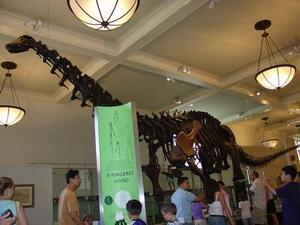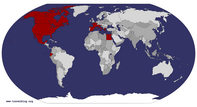Advertisement
Published: October 21st 2007

 New York City
New York City
New York City, New York - United States of AmericaJun 22, 2005
City official name :New York City
Founded date : Location :New York State
Elavation :? ft (? m)
Area :Approximately ? square miles (? km²).
Facts :New York or New York City (officially The City of New York) is an alpha world city in the state of New York. It is the most populous city in the United States and the center of the New York metropolitan area, which, with a population of nearly 19 million, ranks among the largest urban areas in the world. For more than a century, it has been one of the world's leading business, financial and cultural centers and its influence in politics, education, entertainment, sports, media, fashion and the arts all contribute to its status as one of the major global cities. As the home of the United Nations, the city is a hub for international diplomacy. Residents of the city are known as New Yorkers.
New York City comprises five boroughs, each of which is coterminous with a county: The Bronx, Brooklyn, Manhattan, Queens and Staten Island. With over 8.2 million residents within an area of 322 square miles (830 km²), New York

 New York City
New York City
New York City, New York - United States of AmericaCity is the second most densely populated city in the United States, behind nearby Union City, New Jersey.
The city has many neighborhoods and landmarks known around the world. The Statue of Liberty greeted millions of immigrants as they came to America in the late 19th and early 20th centuries, at Ellis Island. Wall Street, in Lower Manhattan, has been a dominant global financial center since World War II and is home to the New York Stock Exchange. The city has been home to several of the tallest buildings in the world, including the Empire State Building and the former twin towers of the World Trade Center, which were destroyed in the September 11, 2001 attacks.
The city is the birthplace of many American cultural movements, including the Harlem Renaissance in literature and visual art, abstract expressionism (also known as the New York School) in painting, and hip hop, punk and Tin Pan Alley in music. In 2005, nearly 170 languages were spoken in the city and 36 percent of its population was born outside the United States. New York is often called the "Big Apple," since it's the largest "bite of the apple" that performers as well

 New York City
New York City
New York City, New York - United States of Americaas professionals in the United States seek to claim ("bite of the apple" is colloquial American English for "opportunity"). New York is also known as "The City that Never Sleeps," not least because its subway system operates around the clock and because many neighborhoods are busy at all hours. This nickname was popularized by Frank Sinatra's song "New York, New York."
The region was inhabited by about 5,000 Lenape Native Americans at the time of its European discovery in 1524 by Giovanni da Verrazzano, an Italian explorer in the service of the French crown, who called it "Nouvelle Angoulême" (New Angoulême). European settlement began with the founding of a Dutch fur trading settlement, later called "Nieuw Amsterdam" (New Amsterdam), on the southern tip of Manhattan in 1614. Dutch colonial Director-General Peter Minuit purchased the island of Manhattan from the Lenape in 1626 (legend, now disproved, says that Manhattan was purchased for $24 worth of glass beads). In 1664, the English conquered the city and renamed it "New York" after the English Duke of York and Albany. At the end of the Second Anglo-Dutch War the Dutch gained control of Run (a much more valuable asset at the time) in

 New York City
New York City
New York City, New York - United States of Americaexchange for the English controlling New Amsterdam (New York) in North America. By 1700, the Lenape population was diminished to 200.
New York City grew in importance as a trading port while under British rule. In 1754, Columbia University was founded under charter by King George II as King's College in Lower Manhattan. The city emerged as the theater for a series of major battles known as the New York Campaign during the American Revolutionary War. The Continental Congress met in New York City and in 1789 the first President of the United States, George Washington, was inaugurated at Federal Hall on Wall Street. New York City was the capital of the United States until 1790.
In the 19th century, the city was transformed by immigration and development. A visionary development proposal, the Commissioners' Plan of 1811, expanded the city street grid to encompass all of Manhattan, and the 1819 opening of the Erie Canal connected the Atlantic port to the vast agricultural markets of the North American interior. By 1835, New York City had surpassed Philadelphia as the largest city in the United States. Local politics fell under the domination of Tammany Hall, a political machine supported

 New York City
New York City
New York City, New York - United States of Americaby Irish immigrants. Public-minded members of the old merchant aristocracy lobbied for the establishment of Central Park, which became the first landscaped park in an American city in 1857. A significant free-black population also existed in Manhattan, as well as in Brooklyn. Slaves had been held in New York through 1827, but during the 1830s New York became the center of interracial abolitionist activism in the North.
Anger at military conscription during the American Civil War (1861-1865) led to the Draft Riots of 1863, one of the worst incidents of civil unrest in American history. In 1898, the modern City of New York was formed with the consolidation of Brooklyn (until then an independent city), Manhattan and municipalities in the other boroughs. The opening of the New York City Subway in 1904 helped bind the new city together. Throughout the first half of the 20th century, the city became a world center for industry, commerce, and communication. However, this development did not come without a price. In 1904, the steamship General Slocum caught fire in the East River, killing 1,021 people on board. In 1911, the Triangle Shirtwaist Factory fire, the city's worst industrial disaster, took the lives of

 New York City
New York City
New York City, New York - United States of America146 garment workers and spurred the growth of the International Ladies' Garment Workers' Union and major improvements in factory safety standards.
In the 1920s, New York City was a major destination for African Americans during the Great Migration from the American South. By 1916, New York City was home to the largest urban African diaspora in North America. The Harlem Renaissance flourished during the era of Prohibition, coincident with a larger economic boom that saw the skyline develop with the construction of competing skyscrapers. New York City became the most populous city in the world in 1948, overtaking London, which had reigned for over a century. The difficult years of the Great Depression saw the election of reformer Fiorello LaGuardia as mayor and the fall of Tammany Hall after eighty years of political dominance.
Returning World War II veterans and immigrants from Europe created a postwar economic boom and the development of huge housing tracts in eastern Queens. New York emerged from the war unscathed and the leading city of the world, with Wall Street leading America's ascendance as the world's dominant economic power, the United Nations headquarters (built in 1952) emphasizing New York's political influence, and the

 New York City
New York City
New York City, New York - United States of Americarise of abstract expressionism in the city precipitating New York's displacement of Paris as the center of the art world. In the 1960s, New York suffered from economic problems, rising crime rates and racial tension, which reached a peak in the 1970s.
In the 1980s, a resurgence in the financial industry improved the city's fiscal health. By the 1990s, racial tensions had calmed, crime rates dropped dramatically, and waves of new immigrants arrived from Asia and Latin America. Important new sectors, such as Silicon Alley, emerged in the city's economy and New York's population reached an all-time high in the 2000 census.
The city was one of the sites of the September 11, 2001 attacks, when nearly 3,000 people died in the destruction of the World Trade Center. The Freedom Tower will be built on the site and is scheduled for completion in 2012.
The building form most closely associated with New York City is the skyscraper that saw New York buildings shift from the low-scale European tradition to the vertical rise of business districts. Surrounded mostly by water, the city's residential density and high real estate values in commercial districts saw the city amass the largest

 New York City
New York City
New York City, New York - United States of Americacollection of individual, free-standing office and residential towers in the world.
New York has architecturally significant buildings in a wide range of styles. These include the Woolworth Building (1913), an early gothic revival skyscraper built with massively scaled gothic detailing able to be read from street level several hundred feet below. The 1916 Zoning Resolution required setback in new buildings, and restricted towers to a percentage of the lot size, to allow sunlight to reach the streets below. The Art Deco design of the Chrysler Building (1930), with its tapered top and steel spire, reflected the zoning requirements. The building is considered by many historians and architects to be New York's finest building, with its distinctive ornamentation such as replicas at the corners of the 61st floor of the 1928 Chrysler eagle hood ornaments and V-shaped lighting inserts capped by a steel spire at the tower's crown. A highly influential example of the international style in the United States is the Seagram Building (1957), distinctive for its facade using visible bronze-toned I-beams to evoke the building's structure. The Condé Nast Building (2000) is an important example of green design in American skyscrapers.
The character of New York's large residential districts is often defined by the elegant brownstone rowhouses, townhouses, and shabby tenements that were built during a period of rapid expansion from 1870 to 1930. Stone and brick became the city's building materials of choice after the construction of wood-frame houses was limited in the aftermath of the Great Fire of 1835. Unlike Paris, which for centuries was built from its own limestone bedrock, New York has always drawn its building stone from a far-flung network of quarries and its stone buildings have a variety of textures and hues. A distinctive feature of many of the city's buildings is the presence of wooden roof-mounted water towers. In the 1800s, the city required their installation on buildings higher than six stories to prevent the need for excessively high water pressures at lower elevations, which could burst municipal water pipes. Garden apartments became popular during the 1920s in outlying areas, including Jackson Heights in Queens, which became more accessible with expansion of the subway.
Advertisement
Tot: 0.13s; Tpl: 0.012s; cc: 8; qc: 26; dbt: 0.0889s; 1; m:domysql w:travelblog (10.17.0.13); sld: 1;
; mem: 1.1mb










